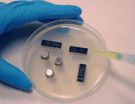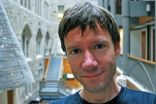(Press-News.org) DURHAM, N.H. – Living in an area where amenities of daily life – groceries, playgrounds, post offices, libraries and restaurants – are within walking distance promotes healthy lifestyles and has positive implications for the environment, research has established. Now, new research from the University of New Hampshire has linked walkable neighborhoods with an increase in social benefits as well.
"We found that neighborhoods that are more walkable had higher levels of social capital such as trust among neighbors and participation in community events," says Shannon Rogers, lead author of the study and a Ph.D. candidate in UNH's Natural Resources and Earth System Science (NRESS) program. She adds that those who have higher levels of positive social capital have been shown to have a higher quality of life through better health and economic opportunities, among other things.
The article, "Examining Walkability and Social Capital as Indicators of Quality of Life at the Municipal and Neighborhood Scales," is published in the recent issue of the journal Applied Research in Quality of Life.
After piloting a study in two Durham neighborhoods, Rogers and the study's coauthors – Kevin Gardner, associate professor of civil and environmental engineering in UNH's Environmental Research Group; fellow NRESS Ph.D. student Cynthia Carlson , and John Halstead, an environmental and resource economist and professor of natural resources and the environment at UNH;– surveyed 700 residents of 20 neighborhoods in two New Hampshire municipalities, Portsmouth and Manchester.
Survey participants self-identified the walkability of their neighborhoods by indicating the number of locations they could walk to in their community; any neighborhood with a mean response of more than seven walkable locations (out of a possible 13) was designated "walkable" by the researchers. To measure social capital, they utilized a well-established scale developed by the Saguaro Seminar at Harvard University, which is headed by "Bowling Alone" author and social capital scholar Robert Putnam.
Those living in more walkable neighborhoods trusted their neighbors more; participated in community projects, clubs and volunteering more; and described television as their major form of entertainment less than survey participants living in less walkable neighborhoods.
Rogers cautions that the study's results are mitigated by a possible self-selection bias: "People who enjoy walking may choose to live in more walkable neighborhoods," she says, adding that it would be naïve to say this study "proves" that walkability affects social capital in neighborhoods.
The research comes from a multidisciplinary team led by Gardner that focuses on the broad issue of community sustainability and resilience and the complex interactions between physical, environmental and social aspects that contribute to sustainability. "We often hear about the triple bottom line of sustainability, but while the environmental and economic aspects are fairly well understood, the social bottom line is less well articulated. This research focuses on what sustainability means to a community and in particular focuses on how it might be measured and improved," says Gardner.
"This study is significant because the relationship between physical community structure and social capital really hasn't been explored much," adds Halstead. "It says something about how we might design neighborhoods in the future not to just save gas but to increase social capital." He notes that it also points to the need to incorporate the relatively new concept of "resiliency" in infrastructure design -- building systems to survive, adapt, and grow in the face of an uncertain future.
The researchers find the link between walkability and social capital an exciting one that, they predict, will continue to be considered by academics and developers alike. Says Rogers, "If you're able to get out easily in your neighborhood and you live closer to other people, you see people you wouldn't ordinarily. That interaction engenders trust and the exchange of information."
INFORMATION:
This research was funded in part by the U.S. Environmental Protection Agency under the Science to Achieve Results (STAR) Graduate Fellowship Program. In addition, Rogers and Carlson received support from the University of New Hampshire's Sustainability Fellowships to the Environmental Research Group.
The University of New Hampshire, founded in 1866, is a world-class public research university with the feel of a New England liberal arts college. A land, sea, and space-grant university, UNH is the state's flagship public institution, enrolling 12,200 undergraduate and 2,300 graduate students.
Walkable neighborhoods richer in social capital, UNH study finds
2010-12-15
ELSE PRESS RELEASES FROM THIS DATE:
High-tech software, umanned planes allow scientists to keep tabs on Arctic seals
2010-12-15
A novel project using cameras mounted on unmanned aircraft flying over the Arctic is serving double duty by assessing the characteristics of declining sea ice and using the same aerial photos to pinpoint seals that have hauled up on ice floes.
The project is the first to use aircraft to monitor ice and seals in remote areas without putting pilots and observers at risk, said Elizabeth Weatherhead of the University of Colorado at Boulder, who is leading the study team. Weatherhead is a senior scientist at the Cooperative Institute for Research in Environmental Sciences, ...
Researchers open the door to biological computers
2010-12-15
Genetically modified cells can be made to communicate with each other as if they were electronic circuits. Using yeast cells, a group of researchers at the University of Gothenburg, Sweden, has taken a groundbreaking step towards being able to build complex systems in the future where the body's own cells help to keep us healthy. The study was presented recently in an article in the scientific journal Nature.
"Even though engineered cells can't do the same job as a real computer, our study paves the way for building complex constructions from these cells," says Kentaro ...
A positive step in the face of uncertainty
2010-12-15
TEMPE, Ariz. – Enormous uncertainty. These two words describe the condition of Phoenix's climate and water supply in the 21st century. Reservoirs have dipped to their lowest levels, continuous drought has plagued the state and forecasts for even warmer summers are predicted. Despite this uncertainty, professors at Arizona State University say there's no need to be fearful because positive impacts can be made.
ASU professors Patricia Gober and Craig Kirkwood working in conjunction with Decision Center for a Desert City (DCDC), which specializes in decision making under ...
UCI researchers find novel memory-enhancing mechanism in brain
2010-12-15
Irvine, Calif., Dec. 14, 2010 — UC Irvine researchers have identified a novel mechanism in the brain that boosts memory.
In collaboration with scientists at Germany's University of Munster, the UCI team found that a small protein called neuropeptide S can strengthen and prolong memories of everything from negative events to simple objects.
According to study leader Rainer Reinscheid, UCI associate professor of pharmaceutical sciences, the discovery could provide important clues about how the brain stores memories and also lead to new treatments for Alzheimer's disease, ...
It's time for a new approach to Alzheimer's disease
2010-12-15
NEW BRUNSWICK, N.J. – Karl Herrup thinks that the national research effort to understand Alzheimer’s disease has gone about as far as it can go with its current theories. And that’s not far enough.
Alzheimer's disease is an incurable, degenerative, eventually fatal disease that attacks cognitive function. It affects more than 26 million people around the world and is the most common form of dementia among people over the age of 65. Over the last three decades, most Alzheimer’s research has been governed by the “amyloid cascade hypothesis.” The theory – which holds that ...
People who believe in justice also see a victim's life as more meaningful after tragedy
2010-12-15
Seeing bad things happen to other people is scary. One way to respond to this is to blame the victim—to look for some reason why it happened to them. But there's another common response, according to a new study published in Psychological Science, a journal of the Association for Psychological Science. The researchers found that people who believe in justice in the world also believe that a tragedy gives the victim's life more meaning.
"A lot of the time when people see someone else suffering, and helping them isn't an option, people will instead justify the fact that ...
Rationalization measures are the main cause of poor work environment
2010-12-15
Managers in the private and public sectors must consider work environment when rationalising production to obtain sustainable systems. A research study published in the journal Applied Ergonomics reveals that rationalisation measures often have a major negative impact on both the physical and psychosocial work environment. "However, the review also presents scientific evidence on how to reduce this problem," says one of the researchers, at the University of Gothenburg.
"Considerable resources all over the world have been invested in dealing with work-related disorders. ...
Anatomy of a shopping spree: Pretty things make us buy more
2010-12-15
Chestnut Hill, Mass. (Dec. 14, 2010) – With the holidays fast approaching and consumers in full shopping mode, new research shows that a seemingly innocent luxury item purchase can lead to an unintended, budget-busting spending spree.
The problem starts with the purchase of a new item, particularly those among designer product lines, luxury branded items, or consumer goods of high-end design. Once home, these items – graced with what researchers call salient design elements, such as a unique pattern or interesting color scheme – can look out of place when compared to ...
Study shows post-9/11 security zones blight landscape
2010-12-15
DENVER (Dec. 14, 2010) – A decade after the 9/11 attacks, significant parts of America's most prominent downtowns remain largely sealed off as `security zones,' but a newly published study by University of Colorado Denver professor Jeremy Németh says this has led to blighted landscapes, limited public access and a need for a new approach to urban planning.
"Our most open, public cities are becoming police states," said Németh, assistant professor of planning and design whose study was recently published in Environment and Planning A. "While a certain amount of security ...
Cell of origin for brain tumors may predict response to therapy
2010-12-15
For patients with glioma, the most common primary brain tumor, new findings may explain why current therapies fail to eradicate the cancer. A UCSF-led team of scientists has identified for the first time that progenitor rather than neural stem cells underly a type of glioma called oligodendroglioma. This distinction explains why oligodendroglioma is more responsive to therapy than other brain tumors such as glioblastoma multiforme.
The finding is significant, the researchers say, because it gives cancer doctors and researchers new cellular pathways to target in developing ...


